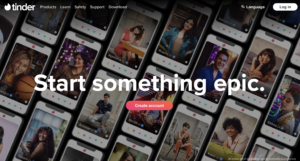Do you remember the first time you swiped right on Tinder, hoping to find that special someone or just a casual connection?
Chances are, you do!
Tinder, the revolutionary dating app, has not only transformed the way we meet people but has also disrupted the dating industry’s financial landscape.
As we delve into the depths of Tinder’s monetization strategy, we can’t help but ask:
- How did Tinder evolve from a simple matchmaking app into a lucrative business empire?
- What tactics did they employ to turn millions of swipes into a treasure trove of revenue?
Join us on this exciting journey as we unveil the secrets behind Tinder’s remarkable success.

1. The Birth of a Swipe Phenomenon
In the annals of digital dating history, Tinder’s birth in 2012 marked a significant turning point. Before we dive into the intricacies of Tinder’s monetization strategy, it’s imperative to understand the app’s humble beginnings. Born as a groundbreaking innovation, Tinder introduced the now-ubiquitous swiping mechanism that revolutionized the world of online dating.
The brilliance of Tinder lay not in its complex algorithms or flashy features but in its elegant simplicity. The ease of swiping left to express disinterest or right to express interest in a potential match resonated with users worldwide.
This intuitive gesture-based interaction made it an instant hit, attracting millions of users within a short span of time. However, what many didn’t realize at the time was that beneath this simplicity was a meticulously crafted plan for monetization.
2. The Freemium Model
Perhaps one of the most ingenious aspects of Tinder’s monetization strategy is its freemium model. At its core, Tinder is free to download and use, granting users the ability to swipe through potential matches and engage with the platform without any upfront costs. This approach dramatically reduces the barrier to entry that often plagues other dating platforms, paving the way for its massive user base.
But the true magic unfolds when users are enticed to delve deeper into the Tinder experience through premium features. Tinder offers a range of subscription levels, including Tinder Plus, Tinder Gold, and Tinder Platinum.
Subscribers gain access to an array of tantalizing features, including unlimited swipes, the invaluable ability to rewind a mistaken swipe, and the coveted “Likes You” feature, which offers a glimpse into who has already expressed interest in their profile.
These premium features form the cornerstone of Tinder’s monetization, compelling users to upgrade for an enhanced and more enjoyable experience.

3. Dynamic Pricing and Regional Strategies
Tinder’s monetization strategy isn’t one-size-fits-all; it’s a carefully tailored approach that adapts to individual users. By considering factors such as age, location, and other demographics, Tinder implements dynamic pricing. This strategy involves offering more affordable premium subscriptions to younger users or those in regions with lower income levels while charging a premium to older users or those residing in wealthier areas.
This dynamic pricing approach not only maximizes Tinder’s revenue potential but also ensures that the app remains accessible and attractive to a diverse user base, regardless of their economic circumstances.
4. In-App Advertising: Fostering a Symbiotic Relationship
Tinder’s monetization strategy is not a one-trick pony; it extends its reach and revenue potential far beyond premium subscriptions. A pivotal component of this multifaceted approach is the seamless integration of in-app advertising, which has not only contributed significantly to Tinder’s financial success but has also forged a symbiotic relationship between the platform and businesses eager to connect with its vast and highly engaged user base.
A. Seamless Integration of In-App Advertising
The beauty of Tinder’s in-app advertising lies in its unobtrusive and natural integration. Unlike traditional banner ads that disrupt the user experience, Tinder’s approach is subtle yet effective. Businesses have the opportunity to promote their profiles and pay for sponsored features, ensuring that their content seamlessly blends into the user interface, appearing as just another potential match for users to explore.
These promoted profiles are strategically positioned within the user’s card stack, making them an integral part of the swiping experience. Users may come across these profiles while engaging with the app, offering businesses an opportunity to catch their attention when they are most receptive as they actively browse through potential matches.
B. Reaching a Vast and Highly Engaged Audience
Tinder’s user base is not only extensive but also highly engaged. The app’s users are often actively seeking connections, making them a prime target for businesses looking to establish meaningful relationships with potential customers.
Whether it’s a restaurant hoping to attract diners, a clothing brand vying for fashion-conscious consumers, or a travel agency aiming to inspire adventurers, Tinder’s diverse user base provides a unique platform for businesses across industries.
Moreover, Tinder’s user demographic spans a wide range of age groups, locations, and interests, further expanding the potential reach for advertisers. This diversity allows businesses to tailor their advertising campaigns to specific segments of the Tinder user base, ensuring that their messages resonate with the intended audience.
C. Strengthening Tinder’s Financial Position
In-app advertising has evolved into a formidable revenue stream for Tinder, complementing the income generated from premium subscriptions. This diversification of revenue sources not only enhances financial stability but also mitigates the risks associated with relying solely on one income stream.
It underscores Tinder’s commitment to a sustainable and robust monetization strategy that can weather market fluctuations and evolving user behaviors.
The revenue generated from in-app advertising contributes to the ongoing development and enhancement of the Tinder platform. It enables Tinder to invest in research and development, improve user experiences, and stay at the forefront of innovation in the competitive world of online dating.
D. A Symbiotic Relationship
The synergy between Tinder and businesses leveraging its in-app advertising platform is symbiotic in nature. Businesses benefit from exposure to a vast and highly engaged audience, potentially leading to increased brand awareness, customer acquisition, and revenue generation.
Simultaneously, Tinder gains additional income streams that help it maintain and enhance its platform while keeping the core user experience free and accessible to a broader audience.

5. Expanding the Portfolio: Match Group’s Strategic Diversification
Tinder’s journey to prominence isn’t solely about refining its core app; it’s also a testament to the strategic prowess of its parent company, Match Group. With an astute eye for the potential of diversification, Match Group has expanded its portfolio to encompass a diverse array of dating apps, including OkCupid, Match.com, and Hinge.
A. Recognizing the Potential for Diversification
Match Group’s decision to diversify its dating app portfolio was a calculated move that capitalized on the evolving landscape of online dating. While Tinder was making waves with its innovative swiping mechanism, Match Group saw the opportunity to address a broader spectrum of dating preferences and demographics.
They understood that one size does not fit all in the world of digital romance, and by offering a variety of dating platforms, they could cater to a wider audience.
B. Enhancing Market Presence
The expansion of Match Group’s portfolio has yielded a significant enhancement in its overall market presence. Each dating app within the group has carved out its own niche, attracting users with specific preferences and expectations.
For instance, OkCupid is known for its comprehensive profiles and algorithm-driven matchmaking, appealing to those seeking more in-depth connections. Match.com, on the other hand, has a more mature user base and focuses on long-term relationships.
By diversifying their offerings in this manner, Match Group effectively covers a broad spectrum of dating needs, from casual encounters on Tinder to more serious and long-term commitments on platforms like Match.com. This diversity enhances their standing in the online dating industry, solidifying their reputation as a major player with a solution for every dating scenario.
C. Generating Additional Revenue Streams
Beyond merely enhancing their market presence, Match Group’s diversified portfolio generates multiple revenue streams. Each app within the group has its own monetization strategy, including premium subscriptions, in-app purchases, and advertising, among others. This multifaceted approach ensures a steady and diversified income stream for the parent company.
Furthermore, as each app caters to different demographics and user preferences, Match Group can optimize its monetization strategy for each platform. This tailored approach allows them to maximize revenue potential while providing users with the features and experiences that best suit their needs and desires.
D. Capitalizing on Unique User Preferences
The genius of Match Group’s diversification lies in its ability to capitalize on the unique preferences of various user groups. People approach dating with a wide range of expectations, from casual connections to serious relationships, and from specific interests to niche dating communities. By offering a suite of apps that cater to these diverse desires, Match Group ensures that each user can find a platform that aligns with their dating goals.
Whether it’s the algorithm-driven compatibility assessments of OkCupid, the commitment-oriented environment of Match.com, or the dynamic and fast-paced world of Tinder, Match Group’s diversified portfolio ensures that no user is left without a suitable option.

6. User Engagement and Retention: Tinder’s Ingenious Strategies
In the competitive realm of mobile apps, user engagement and retention are the lifeblood of success, and Tinder, the world’s leading dating app, is no exception. To keep users actively swiping and returning for more, Tinder has crafted a range of clever tactics that make the app addictive and enjoyable.
These strategies include elements of gamification, such as Super Likes and Boosts, which incentivize user activity by enhancing profile visibility and increasing the chances of meaningful matches.
Furthermore, Tinder continuously refines its matchmaking algorithm to boost match quality, ultimately improving the overall user experience and securing long-term user retention.
A. Gamification: Fueling User Activity
One of Tinder’s most notable features is its ingenious use of gamification. By incorporating elements reminiscent of a game into the dating experience, Tinder has succeeded in making the app engaging and habit-forming. The introduction of Super Likes and Boosts is a prime example of this strategy.
Super Likes allow users to express an exceptionally strong interest in another user’s profile. When a Super Like is sent, it’s accompanied by a distinctive blue star, making the recipient feel special and valued.
This not only boosts the recipient’s self-esteem but also increases the likelihood of a connection being made. It’s a small gesture, but it has a significant impact on user engagement by creating memorable and positive interactions.
Boosts, on the other hand, offer users a way to temporarily increase their profile’s visibility. When a user activates a Boost, their profile is prioritized and shown to more potential matches in their area for a short period.
This not only gives users a sense of control and excitement but also heightens their chances of receiving matches and engaging in conversations. Boosts can be earned or purchased, providing an additional revenue stream for Tinder.
B. Algorithmic Enhancement: Elevating Match Quality
Tinder’s commitment to refining its matchmaking algorithm is another cornerstone of its user engagement and retention strategy. The algorithm, at its core, is designed to understand user preferences and behaviors to deliver more relevant and compatible matches. This not only enhances the likelihood of meaningful connections but also keeps users invested in the platform.
The continuous refinement of the matchmaking algorithm is an ongoing process. It takes into account a multitude of factors, such as the user’s location, age, preferences, and past swiping behavior. As users engage with the app and interact with potential matches, the algorithm learns and adapts, becoming increasingly accurate in its recommendations.
Improved match quality leads to higher user satisfaction, as individuals are more likely to find matches that align with their dating goals and interests. When users consistently experience positive interactions and successful connections, they are more likely to remain active on the platform, leading to enhanced user retention.
C. The Ripple Effect: Engaged and Invested Users
Tinder’s savvy use of gamification and algorithmic refinement creates a positive feedback loop. Users who receive Super Likes or enjoy boosts in profile visibility experience heightened engagement, leading to more matches and conversations. These successful interactions, in turn, boost user satisfaction and reinforce the belief that the app is an effective tool for meeting new people.
This positive feedback loop transforms users into loyal advocates of the platform. They become more invested in the Tinder ecosystem, making it their go-to destination for dating and social interactions. This level of user engagement and commitment is the ultimate goal of any app, and Tinder has mastered the art of creating it.

7. Data Monetization: Leveraging User Insights for Value and Revenue
Tinder’s success isn’t just about matching people; it’s about leveraging the vast reservoir of user data it collects to enhance the user experience and create an additional revenue stream. Beyond the overt sources of revenue, Tinder capitalizes on this treasure trove of user data by analyzing behavior, preferences, and interactions.
This data-driven approach allows Tinder to offer personalized recommendations and insights to its paid subscribers, further enriching the premium experience while creating an additional avenue for revenue generation.
A. Unlocking the Power of User Data
Tinder collects a wealth of data on its users. This includes information on user profiles, swiping behavior, messaging patterns, location data, and even the preferences and interests users share in their profiles. All of this data represents a goldmine of insights waiting to be extracted and utilized.
By leveraging advanced data analytics and machine learning algorithms, Tinder can dissect this data to understand user preferences and behavior patterns. For instance, it can identify the type of profiles a user is more likely to swipe right on, the time of day they are most active on the app, and even the kind of messages that lead to successful connections. This granular level of understanding allows Tinder to provide tailored recommendations and insights to its users.
B. Personalized Recommendations: Enhancing the User Experience
One of the most significant ways Tinder utilizes user data is by offering personalized recommendations to its paid subscribers. This goes beyond simply showing potential matches. Tinder’s algorithm can curate a list of profiles that are more likely to be of interest to a specific user based on their historical swiping behavior and preferences.
For example, if a user consistently swipes right on profiles of dog owners and mentions their love for animals in their own profile, Tinder’s algorithm can prioritize showing them profiles of fellow dog enthusiasts. This level of personalization enhances the user experience by reducing the time and effort needed to find like-minded individuals.
C. Insights and Tips: Empowering Users
Tinder doesn’t stop at personalized recommendations; it also offers insights and tips to help users improve their dating game. These insights can range from suggestions on crafting a more appealing profile to guidance on starting engaging conversations.
For instance, if a user’s messaging patterns show a drop in response rates after sending a certain type of message, Tinder can provide advice on how to approach conversations differently. By arming users with these insights, Tinder empowers them to make better decisions and improves their chances of finding meaningful connections.
D. Creating an Additional Revenue Stream
While enhancing the user experience is a primary goal of data monetization, it also creates an additional avenue for revenue generation. Tinder can offer these personalized insights and tips as part of premium subscription packages or as standalone paid features. Users who value these insights may be willing to pay for access to a more data-informed dating experience.
Furthermore, Tinder can also explore partnerships with external companies interested in accessing anonymized and aggregated user data for market research or advertising purposes. This approach allows Tinder to monetize its data without compromising user privacy.
E. Balancing Value and Privacy
It’s essential to note that while data monetization offers numerous benefits, striking a balance between user value and privacy is crucial. Tinder must prioritize user data security, transparency, and consent to maintain user trust. Ensuring that data usage is in line with privacy regulations and user expectations is paramount.

8. The Future of Tinder’s Monetization Strategy: Navigating a Shifting Landscape
As we gaze into the crystal ball of the future, it’s clear that Tinder’s monetization strategy is poised to undergo further evolution. In a world characterized by rapid technological advancements, ever-changing user preferences, and dynamic market dynamics, Tinder’s ability to adapt and innovate will be paramount to securing its continued success and relevance.
A. Continuous Innovation: Staying Ahead of the Curve
The digital landscape is in a perpetual state of flux, with emerging technologies and trends reshaping how people interact with apps and services. Tinder’s commitment to continuous innovation will be instrumental in maintaining its competitive edge. This innovation might manifest in several ways:
i. AI-Driven Matchmaking
The integration of artificial intelligence (AI) and machine learning can enhance the accuracy of Tinder’s matchmaking algorithms. AI can analyze user behavior and preferences with greater precision, leading to more compatible matches.
ii. Enhanced Safety Features
As online safety becomes an even greater concern, Tinder may invest in advanced safety features, such as identity verification and improved reporting mechanisms, to protect users from harassment and fraudulent activity.
iii. Virtual Dating Experiences
In response to changing dating norms and global events, Tinder may explore virtual dating experiences, including virtual reality (VR) dating, to provide users with unique and immersive ways to connect.
iv. Monetization of Unique Features
Tinder may introduce new premium features or subscription tiers, catering to evolving user needs and expectations while generating additional revenue.
B. Diversification of Revenue Streams: Beyond Swipes and Subscriptions
Tinder’s future monetization strategy is likely to diversify even further. While swipes and premium subscriptions have been the primary sources of revenue, the app may explore additional income streams, such as:
i. Niche Communities
Developing niche dating communities or specialized dating apps for specific interests or demographics can attract users willing to pay for a tailored experience.
ii. Content and Entertainment
Integrating content like dating advice, relationship tips, or exclusive access to dating-related events and experiences can create additional value for users and open up opportunities for monetization.
iii. Advertising Innovation
Tinder may continue to refine its in-app advertising strategies, including more targeted and interactive advertising experiences that deliver value to both users and advertisers.
C. Global Expansion: Capturing New Markets
Tinder’s future growth may involve expanding into new markets and regions. As the app has already achieved global recognition, it can explore untapped markets or adapt its strategies to cater to the unique dating cultures and preferences of different regions.
D. User-Centric Approach: Putting Users First
Throughout its evolution, Tinder’s commitment to user-centricity will remain paramount. Prioritizing user satisfaction, privacy, and security will continue to be a driving force behind its decisions. Listening to user feedback, conducting user research, and adapting based on user needs will be central to maintaining a loyal and engaged user base.
E. Regulatory Compliance: Navigating Legal and Ethical Challenges
The future will bring new regulatory challenges related to data privacy, online safety, and user consent. Tinder must navigate these legal and ethical complexities to maintain user trust and adhere to evolving regulations.
In conclusion, as Tinder charts its course into the future, it is poised for continued success by embracing innovation, diversifying revenue streams, expanding globally, and maintaining a strong user-centric ethos. In an ever-changing digital landscape, Tinder’s ability to adapt and stay attuned to user needs will be the key to its longevity as a leading player in the dynamic world of online dating and monetization strategies.
Celebrate your journey to success with Accredian’s Executive Program in Data Science and AI, inspired by the strategies that drive Tinder’s profitability. Join us in collaboration with IIT, Guwahati, and boost your career to new heights.






